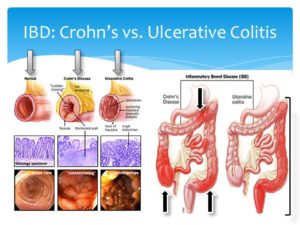
IBD refers to both Crohn’s disease and ulcerative colitis, however they can be distinguished from one another by their symptoms, GI involvement, biopsy, and antibody testing.
You’ve had stomach cramps for weeks, you’re exhausted and losing weight, and you keep having to run to the bathroom. What’s going on?
It could be an inflammatory bowel disease (IBD). But which one?
There are two: Crohn’s disease and ulcerative colitis. They have a lot in common, including long-term inflammation in your digestive system. But they also have some key differences that affect treatment.
By the way, if you hear some people just say “ulcerative colitis” you have sores (ulcers) in the lining of your colon, as well as inflammation there. With Crohn’s disease you may have ulcers.
Facts on Chron’s Disease:
- Inflammation may develop anywhere in the GI tract from the mouth to the anus
- Most commonly occurs at the end of the small intestine
- May appear in patches
- May extend through entire thickness of bowel wall
- About 67% of people in remission will have at least 1 relapse over the next 5 years
Facts on Ulcerative Colitis:
- Limited to the large intestine (colon and rectum)
- Occurs in the rectum and colon, involving a part or the entire colon
- Appears in a continuous pattern
- Inflammation occurs in innermost lining of the intestine
- About 30% of people in remission will experience a relapse in the next year
The symptoms of Crohn’s disease or ulcerative colitis (UC) can be similar. They include:
Belly cramps and pain, Diarrhea, Constipation, An urgent need to have a bowel movement, Feeling like your bowel movement wasn’t complete, Rectal bleeding, Fever, Smaller appetite, Weight loss, Fatigue, Night sweats, Problems with your period. You might skip them, or their timing might be harder to predict.
You might not have all of those symptoms all the time. Both conditions can come and go, switching between flares (when symptoms are worse) and remission (when symptoms ease up or stop).
Crohn’s and ulcerative colitis are most often diagnosed in teenagers and young adults — although they can happen at any age — and tend to run in families.
There are similarities between Crohn’s disease and Ulcerative colitis, which are:
1.)Ulcerative colitis and Crohn’s disease affect men and women equally
2.)The symptoms of ulcerative colitis and Crohn’s disease are very similar
3.) Both diseases often develop in teenagers and young adults although the disease can occur at any age.
4.) The causes of both UC and Crohn’s disease are not known and both diseases have similar types of contributing factors such as environmental, genetic and an inappropriate response by the body’s immune system
There are differences between Crohn’s disease and ulcerative colitis and know what they are:
1.) Location – Ulcerative colitis is limited to affecting the colon (large intestines (colon) to anus; while Crohn’s disease can occur anywhere starting from the mouth to the small intestines to the large intestines (colon) to the anus.
2.) In Crohn’s disease, there are healthy parts of the intestine mixed in between inflamed areas. Ulcerative colitis, on the other hand, is continuous inflammation of the colon.
3.) Ulcerative colitis only affects the inner most lining of the colon while Crohn’s disease can occur in all the layers of the bowel walls.
How to get Diagnosed:
Since the differences between the two conditions mostly revolve around where in the digestive system inflammation happens, the best way for a doctor to give you the right diagnosis is to take a look inside. To look inside is either a endoscopy or colonoscopy depending on where the M.D. thinks the disorder is located.
Prior to these invasive tests the M.D. might order:
X-rays that can show places where your intestine is blocked or unusually narrow.
Contrast X-rays, for which you’ll swallow a thick, chalky, barium liquid so doctors can see how it moves through your system.
CT scans and MRIs to rule out other conditions that might cause symptoms similar to an inflammatory bowel disease.
After the M.D. see’s something on these tests indicating more invasive tests now he or she may order:
Endoscopy, in which a doctor uses a tiny camera on a thin tube to see inside your digestive system.
Specific types of endoscopy can be:
- Examine lower part of your large intestines. Your doctor will call this test “sigmoidoscopy”.
- Look at your entire large intestine. This is a colonoscopy.
- Check the lining of the esophagus, stomach, and duodenum. This is an EGD (esophagogastroduodenoscopy).
- Additional testing to look at your small intestine using a pill-sized camera. This is often called pill, or capsule, endoscopy.
- See the bile ducts in the liver and the pancreatic duct. This test is called ERCP (endoscopic retrograde cholangiopancreatography).
Scientists are working to make two blood tests better at helping to diagnose ulcerative colitis and Crohn’s. They check on levels of certain antibodies found in the blood:
- “pANCA” (perinuclear anti-neutrophil antibodies)
- “ASCA” (anti-Saccharomyces Cerevisiae antibody)
Sometimes, even after all these tests, doctors might not be able to tell which of the two conditions you have. That’s true for 1 in 10 people with IBD. They show signs of both diseases. So they get a diagnosis of “indeterminate colitis,” because it’s not clear which ailment it is.
Finding Your Treatment
Because of the similarities between the conditions, many treatments of ulcerative colitis and Crohn’s disease overlap. These things help for both: